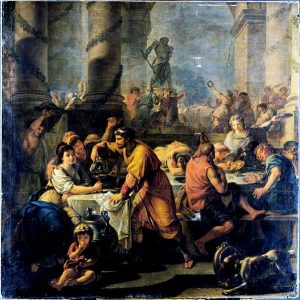December 21, 2018 - Yule
Yule is a Wiccan/Pagan holiday. As with many other pagan celebrations, it celebrates the changing of seasons. Yule happens on the winter solstice, and it celebrates rebirth and renewal. This is because the shortest day and longest night occur on the solstice. After the solstice, the days start to get longer, and Yule celebrates the beginning of the return of the sun.
The earliest known celebrations of Yule are in Norse culture. Their celebration included feasting and merrymaking. Until the 1500s, most animals were killed around the solstice. People did this so they wouldn't have to feed them during the winter, when food was scarce. This meant that at Yule there was plenty of fresh meat available to feast upon.
The Romans celebrated Saturnalia, which was a week-long party, also with feasting and merrymaking. The festival was to honor the god of agriculture, Saturn. One of the main parts of the celebration was giving each other gifts.
The Celts' celebration of Yule included lighting a bonfire and drinking alcoholic spiced cider. Holly, ivy, evergreen trees, and mistletoe were used as decoration. They did this to invite nature spirits to join the celebration. Yule logs were also burned in each house. The log was decorated in seasonal greenery, such as branches. Then, people set it aflame with a piece of last year's log (saved for this purpose). Many other cultures had some sort of winter solstice festival, which often included candles, and bonfires, to provide much needed light on this shortest day.
In present day, pagans take part in many different traditions. Here are a few common traditions:
- Having a feast, or large dinner gathering that focuses on the solstice, but acknowledges other religious celebrations related to the solstice, such as Christmas and New Year’s Eve. They may also exchange gifts.
- Decorating the house with traditional pagan colors of red, green, and white. Wiccans may place holly, ivy, evergreen wreaths and pine cones around the home. They often will include mistletoe as a good luck charm.
- Exchanging gifts or sending greetings with friends and family, in the spirit of Saturnalia
- Meditating in darkness, and then welcoming the birth of the sun by lighting candles and singing pagan songs. If they have a fireplace, they may burn a Yule log and save a bit for next year’s fire. They also may decorate the house with electric lights.
- Donating clothes, money, and time to organizations that help the earth and/or humanity.
Learn more about Yule customs and its meaning with these titles:
December 24, 2018 - Shaheedi Chaar Sahibzaade
You can learn more about Guru Gobind Singh here:
If there's a particular celebration you or someone you know participates in that we missed, let us know by leaving a comment on this post. Or, if you think we got something wrong, please also comment and let us know. We try to be as accurate as possible, but if there's a mistake, we want to correct it.




Add a comment to: The Origins and Practices of Holidays: Yule and Shaheedi Chaar Sahibzaade